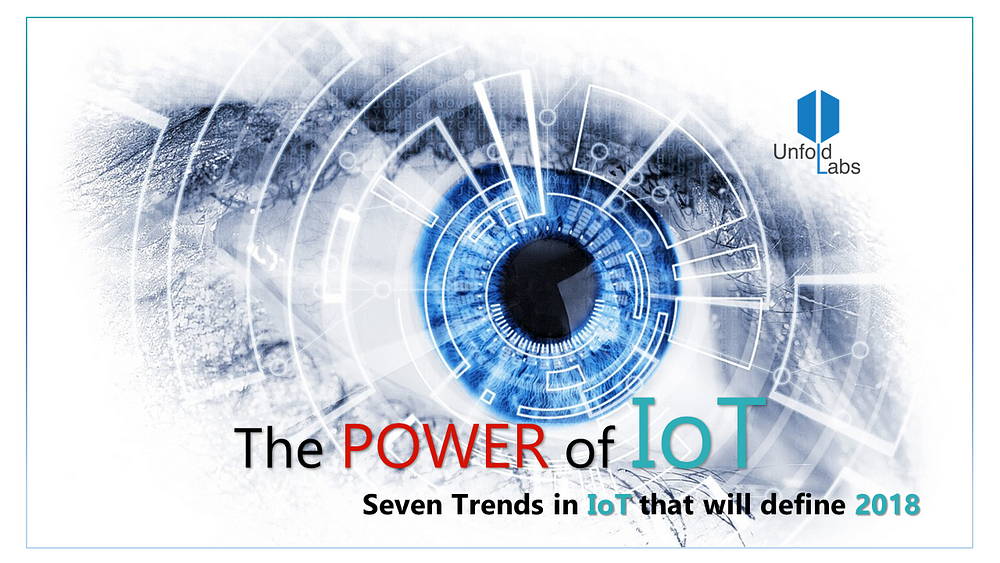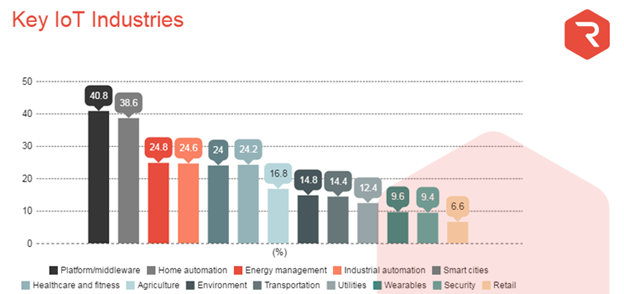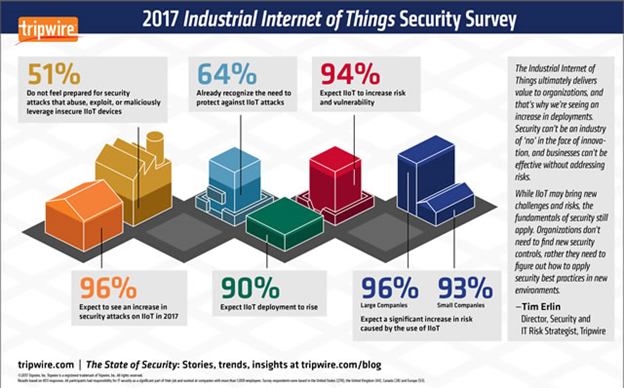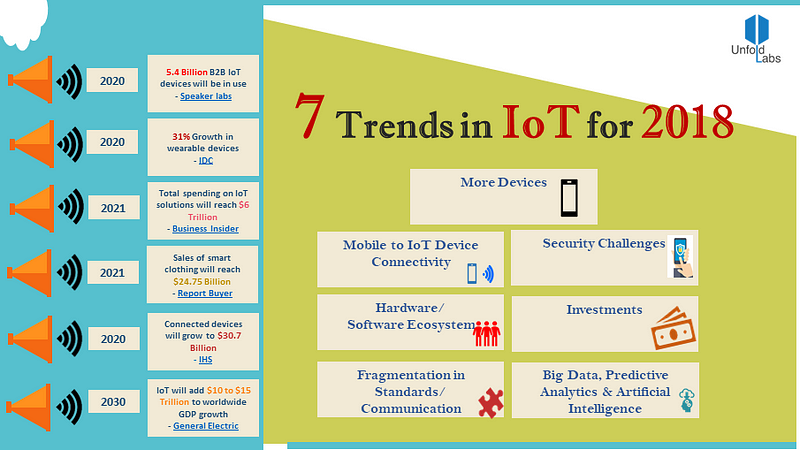Seven Trends in IoT that will define 2018

Our physical world with devices is being reinvented every day with newer products that are getting very personalized, intelligent with unique features. It's almost difficult to imagine life without today's electronic devices, and for the younger generation, it's always been a part of daily life. Encompassing everything from smart home devices to connected and autonomous vehicles to IoT security, the future of IoT remains strong — with statistics to prove it:
- Speaker labs predicts that 5.4 billion B2B IoT devices will be in use in 2020
- IDC forecasts a 31% growth in wearable devices in 2020
- Business Insider predicts that by 2021 the total business spending on IoT solutions will reach $6 trillion
- Reportbuyer forecasts that the sales of smart clothing will reach $24.75 billion in 2021
- According to IHS, the number of connected devices will grow to $30.7 billion in 2020, and $75.4 billion by 2025
- General Electric believes that by 2030, IoT will add $10 to $15 trillion to worldwide GDP growth

Trend 1 — More Devices and Many More Devices
As IoT continues to expand into more verticals, we will certainly see an increase in devices connected to the network in different areas.
In the healthcare industry, where the IoT market is growing, solutions will include more IoT devices for workflow optimization, remote monitoring and medication adherence. In retail, IoT devices will continue to be used to offer customers new services, improve the customer experience and penetrate new markets. Already in use are smartphones for scanning barcodes to get more information on a product, but smart shelves can detect when a store is low on inventory of specific products. It's not just the use of laptops and smartphones as we have seen in the past, there will be a growth in the use of other devices like smart door locks and smart household appliances.
Gartner estimates that by 2020 over 20 billion IoT devices will be installed worldwide.

Trend 2 — Mobile to IoT Device Connectivity
We are already connecting to IoT devices using smartphones to manage thermostats, security cameras, and a number of home appliances. Though web based management is important — mobile will become the de-facto method for people to manage IoT devices. The benefits of mobile applications include boosting customer engagement, reinforcing brands through increased visibility, and streamlining communication.
Trend 3 — Fragmentation in Standards/Communication
Industry leaders like Qualcomm are taking the lead against fragmentation to provide an open standard through the Open Connectivity Foundation (OCF). The foundation is dedicated to providing the key inter-operability elements of IoT solutions & aims to develop standards, promote inter-operability guidelines, and provide a certification program for IoT devices.
Though industry leaders are trying to develop specified standards and get rid of fragmentation, it will still exist. There will be no clear standards in the future of IoT as there will be more companies with diversified protocols. Therefore, there will be no single, inter-operable framework or consistent communication protocols for IoT products and services in the near future.
Trend 4 — Security Challenges
As with most technology, security will be the major challenge that needs to be addressed. Security needs to be implemented to prevent data breaches. As the world becomes increasingly high-tech, devices are easily targeted by cyber-criminals. Internet Trends and Statistics from Evans Data states that 92% of IoT developers say that security will continue to be an issue in the future. Consumers not only have to worry about smartphones, other devices such as baby monitors, cars with WiFi, wearables and medical devices can be breached. Security undoubtedly is a major concern, and vulnerabilities need to be addressed.

Trend 5 — Hardware/Software Ecosystem
The leaders in the industry like Qualcomm and Intel will have an issue with regarding profitability. Due to the lower barriers of entry for hardware development — we will start to see many new chip manufacturers entering the hardware ecosystem, thus placing more price pressure on the larger players in the industry.
In 2018, more companies will emerge into the platform and application layers to manage these devices. This is due to the lower barrier of entry for Software based platforms and cheaper Protocol Stacks.
Trend 6 — Investments
Due to the volume of device shipments there will be more investments in this category. The IDC Worldwide Semiannual IoT Spending Guide forecasts spending on IoT will reach nearly $1.4 trillion in 2021. This coincides with companies continuing to invest in IoT hardware, software, services, and connectivity. Almost every industry will be affected by IoT, which means many companies will benefit from its rapid growth.
The largest IoT investments in 2017 according to the IDC are Manufacturing ($183 billion), Transportation ($85 billion), and Utilities ($66 billion). Consumer IoT purchases ($62 billion) comes in fourth, however, it is believed to grow to the third largest segment in 2021.
Other investment predictions from IDC include:
- The largest spending category until 2021 will be Hardware, but is expected to be overtaken by the faster growing Services category
- Hardware spending will be dominated by modules and sensors that connect end points to networks
- Software spending will be similarly dominated by applications software
- Approximately evenly split in the Services spending category will be ongoing and content services and IT and installation services
- The software category will be the fastest growing area of technology spending — five-year CAGRs of 29.0% for horizontal software and five — year CAGRs 20.5% for analytics software
- Security hardware and software will see increased investment — 15.1% CAGRs for hardware and 16.6% CAGRs for software
Trend 7 — Big Data, Predictive Analytics & Artificial Intelligence
All these IoT devices will share tons of data, hence, Big Data, Predictive Analytics and AI will become increasingly important on these devices. Large corporations have been collecting information on customer behavior. As IoT progresses, this huge amount of customer-related data, including shopping habits and personal information, will translate to an increased amount of unstructured data. The growing amount of unstructured data will drive an abundance of opportunities for AI support of data analytics solutions.

The Future of IoT in 2018
Digitally connected devices are fast becoming a part of our everyday lives. Although the adoption of IoT will be large, it will most likely be slow. The primary reason for this is fragmentation and lack of standardization, both issues that will continue to persist.
Although we will see an increase of IoT devices covering a wide range of industries, it will be difficult for manufacturers to profit from devices alone. Monetizing data and providing IoT services will be another way to profit from this industry.
IoT power issues must also be addressed. This issue, wherein devices consume large amounts of energy and usually requiring recharging often, is not only an issue for IoT devices but for other devices as well. To solve this problem, manufacturers need to find a way to create devices that require less power and/or devices that don't need to be frequently charged.
We target 2020 to be the year where the IoT industry will flourish. We will see an increase in not only IoT devices, but in IoT services and ways to monetize data.
. . .
This post was written by Asokan Ashok, the CEO of UnfoldLabs. Ashok is an expert in driving customer insights into thriving businesses and commercializing products for scale. As a leading strategist in the technology industry, he is great at recommending strategies to address technology & market trends. Highly analytical and an industry visionary, Ashok is a sought after global high-tech industry thought leader and trusted strategic advisor by companies.
. . .
Entrepreneur. Inventor. Product Ideation. Strategist. Visionary. Evangelist. Architect.

